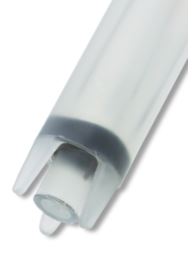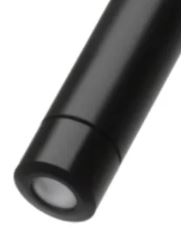Ion-selective electrodes: General tips – Part 1
21.02.2022
Article
en
Theory of ion measurement, types of ion-selective electrodes, why using TISAB or ISA solution for measuring ions, and more on our blog.
Ions – we encounter these tiny charge carriers constantly. Depending on the concentration of certain anions (negative ions) and cations (positive ions), they can have a significant impact on humans and the environment. Thanks to ongoing quality control in several industries such as food and beverage, the metallurgical industry, and water management, defined limits are neither exceeded nor undercut.
So, how can these small, ubiquitous ions be determined? Mistakenly, I thought at first that ion measurement is only possible by means of more costly analytical methods such as ion chromatography (IC), inductively coupled plasma optical emission spectrometry (ICP-OES), or atomic absorption spectroscopy (AAS). A promising cost-efficient alternative to these techniques is to use so-called ion-selective electrodes (ISE).
If you are interested in one or more of these subjects:
- which ion-selective electrodes are available
- the basic theory behind ion-measurement
- why a TISAB or ISA solution needs to be added for the measurement
- what is the best way to care for your ISE
…then you have come to the right place.
Types of ion-selective electrodes
If you want to determine, for example, the fluoride concentration in your toothpaste, the ammonium content of the water in your aquarium, or perhaps how much calcium is really in a fruit juice, then there are many suitable ion-selective electrodes for your application needs. Check out our free Application Bulletins on these subjects below for further information.
Determination of fluoride with an ion-selective electrode
Complexometric titrations with the copper ion-selective electrode
Membrane material
The very first ion-selective electrode was the pH electrode. However, this article will not discuss pH electrodes—you can find more information in our other posts pertaining to this special ISE.
Avoiding the most common mistakes in pH measurement
Aside from the glass membrane used for pH electrodes, there are other membrane materials available for selective measurement of myriad ions. The most widely applied types are listed in Table 1.
| Membrane material | Description | Ions | Close-up view |
|---|---|---|---|
| Crystal membrane | Crystal lattice containing defined gaps for the ion to be measured. | Ag+, Cu2+, Pb2+, Br-, Cl-, CN-, F-, I-, S2- |  |
| Polymer membrane |
Polymer membrane containing a molecule (ionophore) that only binds the ion to be measured. |
Ca2+, K+, Na+, surfactants, NO3- |
 |
| Glass membrane |
Framework of silicate glass with interstitial sites for H+ and Na+. |
Na+, H+ |
 |
| Gas permeable membrane |
Membrane acts as a permeable barrier through which only specific substances can move across. |
NH4+ |
 |
The membrane material can limit the possible matrices in which the ISE can be used. For example, electrodes with a polymer membrane cannot be used to measure ions in organic solvents. For more information on the specific restrictions, check the user manual of your ISE.
Leaflet: Manual for ion-selective electrodes
Basic theory behind ISEs
Measuring range
Each electrode type has its own specific measuring range (see Table 2). Before beginning any ion measurement, first ensure that the ion-selective electrode is able to measure in the concentration range of the sample.
| Cation of interest |
Measuring range |
| Ag+ | 1×10-7 – 1 mol/L |
| Ca2+ |
5×10-7 – 1 mol/L |
| Cd2+ | 1×10-7 – 10-1 mol/L |
| Cu2+ |
1×10-8 – 10-1 mol/L |
| H+ | 1×10-14 – 1 mol/L |
| K+ | 1×10-7 – 1 mol/L |
Na+ (Polymer) Na+ (Glass) |
5×10-6 – 1 mol/L 1×10-5 – 1 mol/L |
| NH4+ |
5×10-6 – 10-2 mol/L |
| Pb2+ | 1×10-6 – 10-1 mol/L |
| Anion of interest |
Measuring range |
| Br- | 1×10-6 – 1 mol/L |
| Cl- | 1×10-5 – 1 mol/L |
| CN- | 8×10-6 – 10-2 mol/L |
| F- |
1×10-6 – sat. mol/L |
| I- | 5×10-8 – 1 mol/L |
| NO3- | 1×10-6 – 1 mol/L |
| S2- |
1×10-7 – 1 mol/L |
Table 2. Each ion-selective electrode has its specific measuring range. Note: The given measuring ranges only apply to ion-selective electrodes from Metrohm.
However, something more important than the measuring range is the linear range. Figure 1 illustrates a measuring range which also includes a linear range. Within this linear range the Nernst equation applies, and the signal is proportional to the analyte concentration. By performing an ion measurement within the linear range, the most precise and reproducible results will be obtained. Find out more about the Nernst equation in our previous blog post.
Outside of the linear range, the curve becomes flatter, and the potential difference becomes smaller, preventing a reliable measurement by standard addition. Even in this non-linear, flattened range, it is possible to determine the ion concentration by means of direct measurement – provided that your ion-selective electrode is also calibrated for this range.
If the concentration is too low or the sensor is saturated, this situation is considered outside of the measuring range. Potential changes can no longer be determined.
Interfering ions
Compared to a pH electrode with a linear range over 14 decades, the sensitivity of ISEs is limited since interfering ions reduce the linear and measuring ranges (see Figure 1).
There are two different types of interfering ions, both outlined in Table 3.
| Interfering ion |
Description |
Impact |
| Irreversible |
|
Destruction of the ISE since the irreversible interfering ion reacts with the membrane and is unavailable for further analysis. |
| Reversible |
|
Erroneous results since the reversible interfering ion binds to the membrane material and contribute to the signal. |
Nowadays, the most important interfering ions for an ISE are known, and information about them is provided by the sensor manufacturer. For the measurement, the impact of interfering ions is considered in a so-called selectivity coefficient, which in turn is used in the Nikolsky equation—an expanded version of the Nernst equation.
| Measuring cation | Interfering ion(s) |
|---|---|
| Ag+ | Hg2+, proteins |
| Ca2+ | Na+, Pb2+, Fe2+, Zn2+, Cu2+, Mg2+ |
| Cu2+ | Ag+, Hg2+, S2-, Cl-, Br-, I-, Fe3+, Cd2+ |
| K+ | Na+, NH4+, Cs+, Li+, H+ |
Na+ (Polymer) Na+ (Glass) |
SCN-, acetate H+, Li+, K+, Ag+ |
| Pb2+ | Ag+, Hg2+, Cu2+, Fe3+, Cd2+ |
| Measuring anion |
Interfering ion(s) |
| Br- | Hg2+, I-, S2-, CN-, NH4+, S2O32- |
| Cl- | Hg2+, Br-, I-, S2-, CN-, NH4+, S2O32- |
| CN- | S2-, Ag+ complexing substances, I-, Cl-, Br- |
| F- | OH- |
| I- | Hg2+, S2-, CN-, Cl-, Br-, S2O32- |
| NO3- | Br-, NO2-, Cl-, acetate |
| S2- | Hg2+, proteins |
Some examples for the most important interfering ions of ISEs are listed in Table 4. For more information on the theoretical background of pH as well as ion-selective electrodes, download our free monograph below.
Ionic strength adjustment
The measurement depends on the activity of the measuring ion in solution, which in turn depends on the ionic strength. For this reason, ion-selective measurements are always carried out in solutions with approximately the same ionic strength. By addition of ionic strength adjuster (ISA) or total ionic strength adjustment buffers (TISAB), a constant ionic background can be achieved.
ISA and TISAB are chemically inert respective to the measurement, and they contain a relatively high concentration of salt so that the ionic strength of the sample solution can be neglected. Some examples can be found in Table 5. Check the user manual of your ISE to find its ideal ISA or TISAB solution.
| Ion to be measured |
ISA / TISAB |
Further information about procedure |
| Fluoride (F-) |
NaCl / glacial acetic acid / CDTA |
Application Bulletin AB-082 |
| Potassium (K+) | c(NaCl) = 0.1–1 mol/L | Application Bulletin AB-134 |
| Sodium (Na+), glass membrane | c(Tris(hydroxymethyl)aminoethane) = 1 mol/L | Application Bulletin AB-083 |
| Sodium (Na+), polymer membrane |
c(CaCl2) = 1 mol/L | |
| Ammonium (NH4+) |
c(NaOH) = 10 mol/L |
Application Bulletin AB-133 |
DO:
- After each measurement or titration, the ISE has to be rinsed thoroughly with distilled water.
DON’T:
- Never use organic solvents for cleaning. They may attack or irreversibly destroy the polymer membrane ISE or reduce the lifetime of your crystal membrane ISE.
Conditioning the ISE
Conditioning steps must be performed before the first use as well as in between measurements. This step activates the measuring membrane and provides a stable equilibrium of the measuring ion in the membrane. By doing so, an accurate ion measurement is possible. An ion standard solution with a concentration of c(ion) = 0.01 mol/L is recommended as the conditioning solution.
Storing the ISE
An overview of proper storage instructions for your ion-selective electrode is shown in Table 6. For more detailed information, check the ISE manual.
| Membrane material | Short storage period |
Long storage period |
| Crystal membrane | In c(ion) = 0.1 mol/L | Dry, with protective cap |
| Polymer membrane | Dry | Dry |
| Polymer membrane, combined | In c(ion) = 0.01–0.1 mol/L | Dry, with some residual moisture |
| Glass membrane | In c(ion) = 0.1 mol/L | In deionized water |
Lifetime of an ISE
The lifetime of an ion-selective electrode depends on several influencing parameters including membrane type, sample matrix, and electrode maintenance. Don’t forget to regularly exchange the electrolyte of your combined ISE or – in case of a separate ISE – your reference electrode. Furthermore, never touch the membrane with bare fingers.
In general, the following can be said:
- Polymer membrane electrodes: Limited lifetime of about half a year since the membrane ages, resulting in a loss of performance.
- Crystal membrane electrodes: Lifetime of several years – the membrane can be regenerated by polishing using an appropriate polishing material. Watch the video below for more details.
Summary
- If you decide to perform an ion measurement using an ion-selective electrode, you must consider the measuring range and any interfering ions that may be present in advance.
- In addition to the membrane type and the sample matrix, the cleaning, storage, and conditioning all have an influence on the lifetime of your ion-selective electrode.
Hungry for more information regarding direct measurement and standard addition? Check out Part 2 where we discuss the different determination methods.
 Share via email
Share via email

